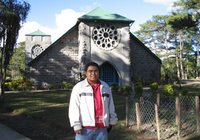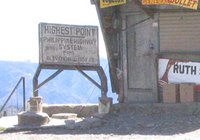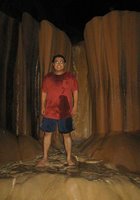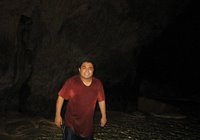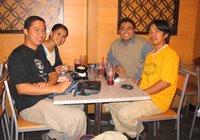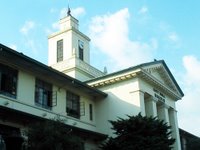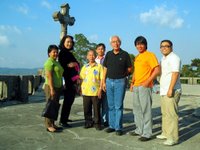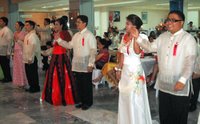by Annalyn S. Jusay
Manila Bulletin (15 May 2006)
Ivan is a young man who is well on his way to exploring the country's 7,107 islands and more. His candid and well-written travel journals also give his readers a glimpse of other exotic places in Asia such as Luang Prabang in Laos, Ayutthaya in Thailand and Siem Reap in Cambodia. Far from exemplifying the jetsetting lifestyle of the rich and famous, Ivan is a passionate advocate of backpacking as a cheap and reasonable way to travel. He says travelling need not be expensive. By observing traditions and policies in other countries, the Philippines can preserve its cultural heritage and offer what is best to all kinds of tourists. More in the following interview:
Q. Please tell us something about yourself.
A. I'm a member of the Board of Trustees of the Heritage Conservation Society and a feisty advocate for the preservation of Philippine architectural heritage. I just finished my MBA in UP and am currently working on various projects in Pampanga including heritage and culinary tours.
Q. When did you start to blog? What was your main purpose in blogging? Did anyone convince you?
A. I started blogging during my trip to Kota Kinabalu and Brunei in April 2005. It was my first backpack trip. I guess since so many people would be asking me when I got back home where I went, what I did, etc., I might as well update everyone through a blog. At that time, I wasn't really serious and simply updated the blog when I went around. And I had my MBA studies to take care of so it was really dependent on available time. But my heritage advocacy was very evident even in those early posts.
Then I got to attend a workshop last March on blogging and podcasting as political communication tools sponsored by the Friedrich Naumann Foundation. That is when I got serious. By that time, I had already completed my academic requirements and had several trips lined up. So that's how it took off.
Q. Can you tell us more about your advocacy for backpacking and heritage conservation in the country? What do you think is needed to promote this among the general population?
A. People often think that to travel, you need a lot of money. Yes, you need funds to go places but it need not be a hefty amount. And backpacking is one way for you to see the sights without creating a big hole in your pockets. Once people know how cheap travelling can be, backpacking will definitely take off.
On heritage, we have to fight to preserve our heritage primarily for future generations of Filipinos. We must preserve our national identity for our children and their children. Second, for crying out loud, cultural and natural heritage is what foreign tourists come here to see! And when we destroy our heritage, we are bringing down our market value in the multi-billion dollar tourism industry.
Many of our local officials and priests destroy heritage in the name of modernization and progress. Heritage creates local identity. Local identity is a very strong rallying point towards progress. Little do our local officials know that they are actually lowering the standard of living in their area by converting it into an ordinary, nondescript place. As the Filipino proverb goes, "Ang hindi lumingon sa pinaggalingan ay hindi makakarating sa paroroonan." You actually think that salawikain would survive this long if it weren't true?
Q. In essence, what do you think is wrong with Philippine tourism? What is good about it?
A. First, we don't know the market. As I mentioned earlier, foreigners travel to visit the cultural and natural heritage of other countries. Would you go to China to visit an SM mall for example? I'd go there to visit the Forbidden City or the Great Wall of China! When we go to Europe, we visit old cities like Paris, Rome, Venice, Madrid, London, etc. and they are all magnificent because of their architectural heritage.
I think policy makers should read this article entitled Finding Heritage Value in The Wall Street Journal about how China is starting to realize that preserving archaeological sites may be a better idea than building shopping malls.
Second is the cost of travelling to the Philippines. Would you believe that the Philippines is relatively expensive to the traveler compared to the rest of Southeast Asia? According to Lonely Planet, you need an average daily budget of US$25 in the Philippines, the second highest in the ASEAN. Compare this to Thailand's US$11 to 15 or US$12 in Malaysia. So we have to bring down the costs of lodging, food and transportation among others.
Since we target mainstream tourism too much, we fail to realize that the bigger market is the budget traveler, the backpacker. You would be surprised with the ratio of foreigners to locals in major tourist cities in our Southeast Asian neighbors such as Cambodia, Laos, Vietnam and Thailand. The reason they are attracting millions of tourists is because they are backpacker friendly.
One surprise was Luang Prabang in Laos which was so remote, I think Sagada is many times more accessible. But lo and behold, it was teeming with tourists! There was a nearby waterfalls and there were more than a thousand foreigners who paid US$1.50 just to enter. And to think we have more majestic waterfalls in the country. But I have yet to see one that could attract that much foreigners.
The DOT will have to realize that the backpacker is a powerful market. You would be surprised that Americans, Canadians, French or Australians go for the US$5 a night accomodations with just the basic bed and electric fan, and a common shower. Others would even opt for dormitory rooms. For meals, its street food served by hawkers. That's why we have to strive to keep street food clean. The DOT will have to endeavor to create established backpack trails if it wants to attract the tourists which visit our neighbors in the droves. I'm willing to help them if they need it. I have more to say about our need to catch up but I suggest you visit my blog instead and click on the international destinations in the blog index.
Q.What is the best thing that blogging has brought you since you started? Have you received any memorable feedbacks from your readers?
A. Blogging made me more observant of the places I visit. That is why I learn more lessons when I go around. It's fun and encouraging when you find out people read what you have to say. Many comments let you know that you are not alone in your beliefs and advocacies.
Q. What are your observations of the Philippine blogosphere?
A. It is booming! Although there are those who simply blog about their daily routines, there are many who have a lot to say. I hope that more Filipinos read local blogs or better yet, start their own blogs.
Q. Do you think travelling and blogging go together? Do you think blogging will help your travelling, and vice versa?
A. Definitely! I'm happy that I blogged about my trips since I could go back and visit those old entries to remind me about what I did, where I went, etc. It also reminds me of the lessons learned which I hope to apply locally in the future. As I said, blogging made me more aware, observant and appreciative of the things I see, do and experience. And travelling helps me blog since if I don't travel, I have nothing to write about.
Q. What do you think are the qualities of a good blogger?
A. A good blogger should be consistent with regard to topic and content, and frequency of updates. Second, he or she should be opinionated. If what you write about is just your daily routine, you'll bore people to death.
Q. Your online/blogging habits.
A. I'm online for as long as there is a computer and an internet connection.
Q. Plans for your blog.
A. Maybe a new layout, but I'm happy the way the current one is going. You could visit other heritage blogs I manage for the Heritage Conservation Society like "ICOMOS Philippines" (http://icomosphilippines
For comments and inquiries, write to annalyn.jusay@gmail.com

